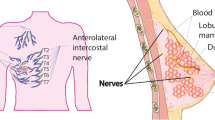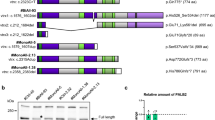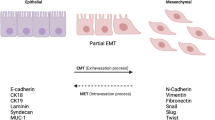Abstract
Ligands of the TGF-β superfamily are unique in that they signal through transmembrane receptor serine-threonine kinases, rather than tyrosine kinases. The receptor complex couples to a signal transduction pathway involving a novel family of proteins, the Smads. On phosphorylation, Smads translocate to the nucleus where they modulate transcriptional responses. However, TGF-βs can also activate the mitogen-activated protein kinase (MAPK)4 pathway, and the different biological responses to TGF-β depend to varying degrees on activation of either or both of these two pathways. The Smad pathway is a nexus for cross-talk with other signal transduction pathways and for modulation by many different interacting proteins. Despite compelling evidence that TGF-β has tumor suppressor activity in the mammary gland, neither TGF-β receptors nor Smads are genetically inactivated in human breast cancer, though receptor expression is reduced. Possible reasons are discussed in relation to the dual role of TGF-β as tumor suppressor and oncogene.
Similar content being viewed by others
REFERENCES
A.B. Roberts and M.B. Sporn (1990). The transforming growth factors-β. In M.B. Sporn and A.B. Roberts (eds.), Handbook of Experimental Pharmacology. Peptide Growth Factors and Their Receptors. Springer-Verlag, Berlin, 95:419–472.
C.W. Daniel, S. Robinson, and G.B. Silberstein (1996). The role of TGF-β in patterning and growth of the mammary ductal tree. J. Mamm. Gland Biol. Neoplasia 1:331–341.
L.M. Wakefield, Y. Yang, and O. Dukhanina (2000). Transforming growth factor-α and breast cancer. Lessons learned from genetically altered mouse models. Breast Cancer Res. 2:100–106.
D. J. Phippard, S. J. Weber-Hall, P. T. Sharpe, M. S. Naylor, H. Jayatalake, R. Maas, I. Woo, D. Roberts-Clark, P. H. Francis-West, Y. H. Liu, R. Maxson, R. E. Hill, and T. C. Dale (1996). Regulation of Msx-1, Msx-2, Bmp-2 and Bmp-4 during foetal and postnatal mammary gland development. Development 122:2729–2737.
J. Massague and D. Wotton (2000). Transcriptional control by the TGF-β/Smad signaling system. EMBO J. 19:1745–1754.
P. ten Dijke, K. Miyazono, and C. H. Heldin (2000). Signaling inputs converge on nuclear effectors inTGF-β signaling.Trends Biochem. Sci. 25:64–70.
M. P. de Caestecker, E. Piek, and A.B. Roberts (2000). The role of TGF-β signaling in cancer. J. Natl. Cancer Inst. 92:1388–1402.
S.D. Robinson, G. B. Silberstein, A. B. Roberts, K. C. Flanders, and C.W. Daniel (1991). Regulated expression and growth inhibitory effects of transforming growth factor-α isoforms in mouse mammary gland development. Development 113:867–878.
H. Joseph, A. E. Gorska, P. Sohn, H. L. Moses, and R. Serra (1999). Overexpression of a kinase-deficient transforming growth factor-α type II receptor in mouse mammary stroma results in increased epithelial branching. Mol. Biol. Cell. 10:1221–1234.
E. C. Kordon, R. A. McKnight, C. Jhappan, L. Hennighausen, G. Merlino, and G. H. Smith (1995). Ectopic TGF-β 1 expression in the secretory mammary epithelium induces early senescence of the epithelial stem cell population. Dev. Biol. 168:47–61.
A. E. Gorska, H. Joseph, R. Derynck, H. L. Moses, and R. Serra (1998). Dominant-negative interference of the transforming growth factor α type II receptor in mammary gland epithelium results in alveolar hyperplasia and differentiation in virgin mice. Cell Growth Differ. 9:229–238.
A. V. Nguyen and J. W. Pollard (2000). Transforming growth factor α3 induces cell death during the first stage of mammary gland involution. Development 127:3107–3118.
C. L. Arteaga and H. L. Moses, Eds. (1996). Transforming growth factor-α: Physiology, development, and neoplasia. J. Mam. GlandBiol. Neoplasia 1:327–397.
D. F. Pierce, Jr., A. E. Gorska, A. Chytil, K. S. Meise, D. L. Page, R. J. Coffey, Jr., and H. L. Moses (1995). Mammary tumor suppression by transforming growth factor α1 transgene expression. Proc. Natl. Acad. Sci. U.S.A. 92:4254–4258.
E. P. Bottinger, J. L. Jakubczak, D. C. Haines, K. Bagnall, and L. M. Wakefield (1997). Transgenic mice overexpressing a dominant-negative mutant type II transforming growth factor α receptor show enhanced tumorigenesis in the mammary gland and lung in response to the carcinogen 7,12-dimethylbenz-[α]-anthracene. Cancer Res. 57:5564–5570.
T. M. Fynan and M. Reiss (1993). Resistance to inhibition of cell growth by transforming growth factor-α and its role in oncogenesis. Crit. Rev. Oncogene. 4:493–540.
H. Gobbi, C. L. Arteaga, R. A. Jensen, J. F. Simpson, W. D. DuPont, S. J. Olson, P. A. Schuyler, W. D. J. Plummer, and D. L. Page (2000). Loss of expression of transforming growth factor α type II receptor correlates with high tumor grade in human breast in situ and invasive carcinomas. Histopathology 36:168–177.
S. M. Gorsch, V. A. Memoli, T. A. Stukel, L. I. Gold, and B. A. Arrick (1992). Immunohistochemical staining for transforming growth factor α1 associates with disease progression in human breast cancer. Cancer Res. 52:6949–6952.
R. A. Walker and S. J. Dearing (1992). Transforming growth factor α1 in ductal carcinoma in situ and invasive carcinomas of the breast. Eur. J. Cancer 28:641–644.
J. Massague (1998). TGF-β signal transduction. Ann. Rev. Biochem. 67:753–791.
S. P. Oh, T. Seki, K. A. Goss, T. Imamura, Y. Yi, P. K. Donahoe, L. Li, K. Miyazono, P. ten Dijke, S. Kim, and E. Li (2000) Activin receptor-like kinase 1 modulates transforming growth factor-β1 signaling in the regulation of angiogenesis. Proc. Natl. Acad. Sci. U.S.A. 97:2626–2631.
X. Liu, J. Yue, R. S. Frey, Q. Zhu, and K. M. Mulder (1998). Transforming growth factor α signaling through Smad1 in human breast cancer cells. Cancer Res. 58:4752–4757.
K. M. Mulder (2000). Role of Ras and Mapks in TGFα signaling. Cytokine. Growth FactorRev. 11:23–35.
A. Axmann, D. Seidel, T. Reimann, U. Hempel, and K. W. Wenzel (1998). Transforming growth factor-α1-induced activation of the Raf-MEK-MAPK signaling pathway in rat lung fibroblasts via a PKC-dependent mechanism. Biochem. Biophys. Res. Commun. 249:456–460.
R. S. Frey and K. M. Mulder (1997). TGFα regulation of mitogen-activated protein kinases in human breast cancer cells. Cancer Lett. 117:41–50.
D. T. Denhardt (1996). Oncogene-initiated aberrant signaling engenders the metastatic phenotype: Synergistic transcription factor interactions are targets for cancer therapy. Crit. Rev. Oncog. 7:261–291.
M. E. Engel, M. A. McDonnell, B. K. Law, and H. L. Moses (1999). Interdependent SMAD and JNK signaling in transforming growth factor-α-mediated transcription. J. Biol. Chem. 274:37413–37420.
M. P. de Caestecker, W. T. Parks, C. J. Frank, P. Castagnino, D. P. Bottaro, A.B. Roberts, and R. J. Lechleider (1998). Smad2 transduces common signals from receptor serine-threonine and tyrosine kinases. Genes Dev. 12:1587–1592.
M. Kretzschmar, J. Doody, I. Timokhina, and J. Massague (1999). A mechanism of repression of TGFα/ Smad signaling by oncogenic Ras. Genes Dev. 13:804–816.
K. Gritsman, J. Zhang, S. Cheng, E. Heckscher, W. S. Talbot, and A. F. Schier (1999). The EGF-CFC protein one-eyed pinhead is essential for nodal signaling. Cell 97:121–132.
M. Nishita, M. K. Hashimoto, S. Ogata, M.N. Laurent, N. Ueno, H. Shibuya, and K. W. Cho (2000). Interaction between Wnt and TGF-β signaling pathways during formation of Spemann's organizer. Nature 403:781–785.
B. A. Hocevar, T. L. Brown, and P. H. Howe (1999). TGF-β induces fibronectin synthesis through a c-Jun N-terminal kinasedependent, Smad4-independent pathway. EMBO J. 18:1345–1356.
C. M. Perou, S. S. Jeffrey, M. van de Rijn, C. A. Rees, M. B. Eisen, D. T. Ross, A. Pergamenschikov, C. F. Williams, S. X. Zhu, J. C. Lee, D. Lashkari, D. Shalon, P. O. Brown, and D. Botstein (1999). Distinctive gene expression patterns in human mammary epithelial cells and breast cancers. Proc. Natl. Acad. Sci. U.S.A. 96:9212–9217.
X. Yang, J. J. Letterio, R. J. Lechleider, L. Chen, R. Hayman, H. Gu, A. B. Roberts, and C. Deng (1999). Targeted disruption of SMAD3 results in impaired mucosal immunity and diminished T cell responsiveness to TGF-β. EMBO J. 18:1280–1291.
J. L. Dai, M. Schutte, R. K. Bansal, R. E. Wilentz, A. Y. Sugar, and S. E. Kern (1999). Transforming growth factor-α responsiveness in DPC4/SMAD4-null cancer cells. Mol. Carcinog. 26:37–43.
M. H. Barcellos-Hoff (1996). Latency and activation in the control of TGF-β. J. Mam. Gland Biol. Neoplasia 1:353–363.
M. H. Barcellos-Hoff and K. B. R. Ewan (2000). Transforming growth factor-α and breast cancer: Mammary gland development. Breast Cancer Res. 2:92–99.
G.W. Robinson and L. Hennighausen (1997). Inhibins and activins regulate mammary epithelial cell differentiation through mesenchymal-epithelial interactions. Development 124:2701–2708.
Q. Y. Liu, B. Niranjan, P. Gomes, J. J. Gomm, D. Davies, R. C. Coombes, and L. Buluwela (1996). Inhibitory effects of activin on the growth and morphogenesis of primary and transformed mammary epithelial cells. Cancer Res. 56:1155–1163.
H. Gobbi, W. D. DuPont, J. F. Simpson, W. D. J. Plummer, P. A. Schuyler, S. J. Olson, C. L. Arteaga, and D. L. Page (1999). Transforming growth factor-α and breast cancer risk in women with mammary epithelial hyperplasia. J. Natl. Cancer Inst. 91:2096–2101.
M. Macias-Silva, P. A. Hoodless, S. J. Tang, M. Buchwald, and J. L. Wrana (1998). Specific activation of Smad1 signaling pathways by the BMP7 type I receptor, ALK2. J. Biol. Chem. 273:25628–25636.
F. Pouliot and C. Labrie (1999). Expression profile of agonistic Smads in human breast cancer cells: Absence of regulation by estrogens. Int. J. Cancer 81:98–103.
S. Markowitz, J. Wang, L. Myeroff, R. Parsons, L. Sun, J. Lutterbaugh, R. S. Fan, E. Zborowska, K. W. Kinzler, and B. Vogelstein (1995). Inactivation of the type II TGF-β receptor in colon cancer cells with microsatellite instability. Science 268:1336–1338.
F. Vincent, K. Hagiwara, Y. Ke, G. D. Stoner, D. J. Demetrick, and W. P. Bennett (1996). Mutation analysis of the transforming growth factor α type II receptor in sporadic human cancers of the pancreas, liver, and breast. Biochem. Biophys. Res. Commun. 223:561–564.
S. Takenoshita, A. Mogi, M. Tani, H. Osawa, H. Sunaga, H. Kakegawa, Y. Yanagita, T. Koida, M. Kimura, K. I. Fujita, H. Kato, R. Kato, and Y. Nagamachi (1998). Absence of mutations in the analysis of coding sequences of the entire transforming growth factor-α type II receptor gene in sporadic human breast cancers. Oncol. Rep. 5:367–371.
S. Tomita, S. Deguchi, T. Miyaguni, Y. Muto, T. Tamamoto, and T. Toda (1999). Analyses of microsatellite instability and the transforming growth factor-α receptor type II gene mutation in sporadic breast cancer and their correlation with clinicopathological features. Breast Cancer Res. Treat. 53:33–39.
F. Vincent, M. Nagashima, S. Takenoshita, M. A. Khan, A. Gemma, K. Hagiwara, and W. P. Bennett (1997). Mutation analysis of the transforming growth factor-α type II receptor in human cell lines resistant to growth inhibition by transforming growth factor-α. Oncogene 15:117–122.
T. Chen, D. Carter, L. Garrigue-Antar, and M. Reiss (1998). Transforming growth factor α type I receptor kinase mutant associated with metastatic breast cancer. Cancer Res. 58:4805–4810.
F.C. Schmitt, R. Soares, H. Gobbi, F. Milanezzi, F. Santos-Silva, L. Cirnes, C. Costa, and R. Seruca (1999). Microsatellite instability in medullary breast carcinomas. Int. J. Cancer 82:644–647.
R. Anbazhagan, D. M. Bornman, J. C. Johnston, W. H. Westra, and E. Gabrielson (1999). The S387Y mutations of the transforming growth factor-α receptor type I gene is uncommon in metastases of breast cancer and other common types of adenocarcinoma. Cancer Res. 59:3363–3364.
D. Chakravarthy, A. R. Green, V. L. Green, M. J. Kerin, and V. Speirs (1999). Expression and secretion of TGF-β isoforms and expression of TGF-β-receptors I, II and III in normal and neoplastic human breast. Int. J. Oncol. 15:187–194.
G. J. Riggins, K.W. Kinzler, B. Vogelstein, and S. Thiagalingam (1997). Frequency of Smad gene mutations in human cancers. Cancer Res. 57:2578–2580.
M. Schutte, R. H. Hruban, L. Hedrick, K. R. Cho, G. M. Nadasdy, C. L. Weinstein, G. S. Bova, W. B. Isaacs, P. Cairns, H. Nawroz, D. Sidransky, R. A. J. Casero, P. S. Meltzer, S. A. Hahn, and S. E. Kern (1996). DPC4gene in various tumor types. Cancer Res. 56:2527–2530.
W.M. Grady, A. Rajput, L. Myeroff, D.F. Liu, K. Kwon, J. Willis, and S. Markowitz (1998). Mutation of the type II transforming growth factor-α receptor is coincident with the transformation of human colon adenomas to malignant carcinomas. Cancer Res. 58:3101–3104.
R. E. Wilentz, C. A. Iacobuzio-Donahue, P. Argani, D. M. McCarthy, J. L. Parsons, C. J. Yeo, S. E. Kern, and R. H. Hruban (2000). Loss of expression of Dpc4 in pancreatic intraepithelial neoplasia: Evidence that DPC4 inactivation occurs late in neoplastic progression. Cancer Res. 60:2002–2006.
C. L. Arteaga, A. K. Tandon, D. D. Von Hoff, and C. K. Osborne (1988). Transforming growth factor α: Potential autocrine growth inhibitor of estrogen receptor-negative human breast cancer cells. Cancer Res. 48:3898–3904.
D. Wang, L. Sun, E. Zborowska, J. K. Willson, J. Gong, J. Verraraghavan, and M.G. Brattain (1999). Control of type II transforming growth factor-α receptor expression by integrin ligation. J. Biol. Chem. 274:12840–12847.
Y. Liu, X. Zhong, W. Li, M.G. Brattain, and S. S. Banerji (2000). The role of Sp1 in the differential expression of transforming growth factor-α receptor type II in human breast adenocarcinoma MCF-7 cells. J. Biol. Chem. 275:12231–12236.
J. Chang, C. Lee, K. B. Hahm, Y. Yi, S. G. Choi, and S. J. Kim (2000). Over-expression of ERT(ESX/ESE-1/ELF3), an ets related transcription factor, induces endogenous TGF-β type II receptor expression and restores the TGF-β signaling pathway in Hs578t human breast cancer cells. Oncogene 19:151–154.
L. Sun, G. Wu, J. K. Willson, E. Zborowska, J. Yang, I. Rajkarunanayake, J. Wang, L. E. Gentry, X. F. Wang, and M. G. Brattain (1994). Expression of transforming growth factor α type II receptor leads to reduced malignancy in human breast cancer MCF-7 cells. J. Biol. Chem. 269:26449–26455.
N. Dumont and C. L. Arteaga (2000). Transforming growth factor-α and breast cancer: Tumor promoting effects of transforming growth factor-α. Breast Cancer Res. 2:125–132.
M. G. Alexandrow, M. Kawabata, M. Aakre, and H. L. Moses (1995). Overexpression of the c-Myc oncoprotein blocks the growth-inhibitory response but is required for the mitogenic effects of transforming growth factor α1. Proc. Natl. Acad. Sci. U.S.A. 92:3239–3243.
P. Sun, P. Dong, K. Dai, G. J. Hannon, and D. Beach (1998). p53-Independent Role of MDM2 in TGF-β1 Resistance. Science 282:2270–2272.
J. Donovan and J. Slingerland (2000). Transforming growth factor-α and breast cancer: Cell cycle arrest by transforming growth factor-α and its disruption in cancer. Breast Cancer Res. 2:116–124.
M. T. Hartsough, R. S. Frey, P. A. Zipfel, A. Buard, S. J. Cook, F. McCormick, and K. M. Mulder (1996). Altered transforming growth factor signaling in epithelial cells when ras activation is blocked. J. Biol. Chem. 271:22368–22375.
B. J. Park, J. I. Park, D. S. Byun, J. H. Park, and S. G. Chi (2000). Mitogenic conversion of transforming growth factor-α1 effect by oncogenic Ha-Ras-induced activation of the mitogenactivated protein kinase signaling pathway in human prostate cancer. Cancer Res. 60:3031–3038.
N. Johansson, R. Ala-aho, V. Uitto, R. Grenman, N. E. Fusenig, C. Lopez-Otin, and V. M. Kahari (2000). Expression of collagenase-3 (MMP-13) and collagenase-1 (MMP-1) by transformed keratinocytes is dependent on the activity of p38 mitogen-activated protein kinase. J. Cell Sci. 113:227–235.
J. F. Santibanez, M. Iglesias, P. Frontelo, J. Martinez, and M. Quintanilla (2000). Involvement of the Ras/MAPK signaling pathway in the modulation of urokinase production and cellular invasiveness by transforming growth factor-α(1) in transformed keratinocytes. Biochem. Biophys. Res Commun. 273:521–527.
M. Oft, J. Peli, C. Rudaz, H. Schwarz, H. Beug, and E. Reichmann (1996). TGF-β1 and Ha-Ras collaborate in modulating the phenotypic plasticity and invasiveness of epithelial tumor cells. Genes Dev. 10:2462–2477.
E. Piek, A. Moustakas, A. Kurisaki, C. H. Heldin, and P. ten Dijke (1999). TGF-β type I receptor/ALK-5 and Smad proteins mediate epithelial to mesenchymal transdifferentiation in NMuMG breast epithelial cells. J. Cell Sci. 112:4557–4568.
C. Wong, E.M. Rougier-Chapman, J. P. Frederick, M. B. Datto, N. T. Liberati, J. M. Li, and X. F. Wang (1999). Smad3-Smad4 and AP-1 complexes synergize in transcriptional activation of the c-Jun promoter by transforming growth factor α. Mol. Cell. Biol. 19:1821–1830.
D. A. Dillon, C. L. Howe, S. Bosari, and J. Costa (1998). The molecular biology of breast cancer: Accelerating clinical applications. Crit. Rev. Oncogene. 9:125–140.
B. Tang, K. de Castro, H.E. Barnes, W.T. Parks, L. Stewart, E. P. Bottinger, D. Danielpour, and L. M. Wakefield (1999). Loss of responsiveness to transforming growth factor α induces malignant transformation of nontumorigenic rat prostate epithelial cells. Cancer Res. 59:4834–4842.
R. H. Chen, R. Ebner, and R. Derynck (1993). Inactivation of the type II receptor reveals two receptor pathways for the diverse TGF-β activities. Science 260:1335–1338.
B. A. Hocevar, T. L. Brown, and P. H. Howe (1999). TGF-β induces fibronectin synthesis through a c-Jun N-terminal kinasedependent, Smad4-independent pathway. EMBO J. 18:1345–1356.
G. Portella, S. A. Cumming, J. Liddell, W. Cui, H. Ireland, R. J. Akhurst, and A. Balmain (1998). Transforming growth factor α is essential for spindle cell conversion of mouse skin carcinoma in vivo: Implications for tumor invasion. Cell Growth Differ. 9:393–404.
V. J. Bubb, L. J. Curtis, C. Cunningham, M. G. Dunlop, A. D. Carothers, R. G. Morris, S. White, C. C. Bird, and A. H. Wyllie (1996). Microsatellite instability and the role of hMSH2 in sporadic colorectal cancer. Oncogene 12:2641–2649.
Author information
Authors and Affiliations
Corresponding author
Rights and permissions
About this article
Cite this article
Wakefield, L.M., Piek, E. & Böttinger, E.P. TGF-β Signaling in Mammary Gland Development and Tumorigenesis. J Mammary Gland Biol Neoplasia 6, 67–82 (2001). https://doi.org/10.1023/A:1009568532177
Issue Date:
DOI: https://doi.org/10.1023/A:1009568532177




